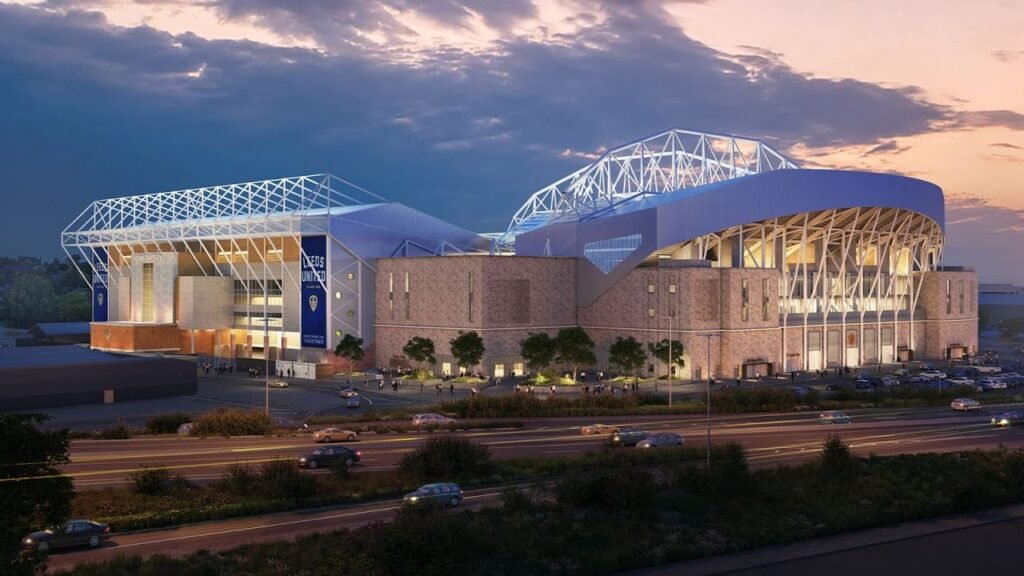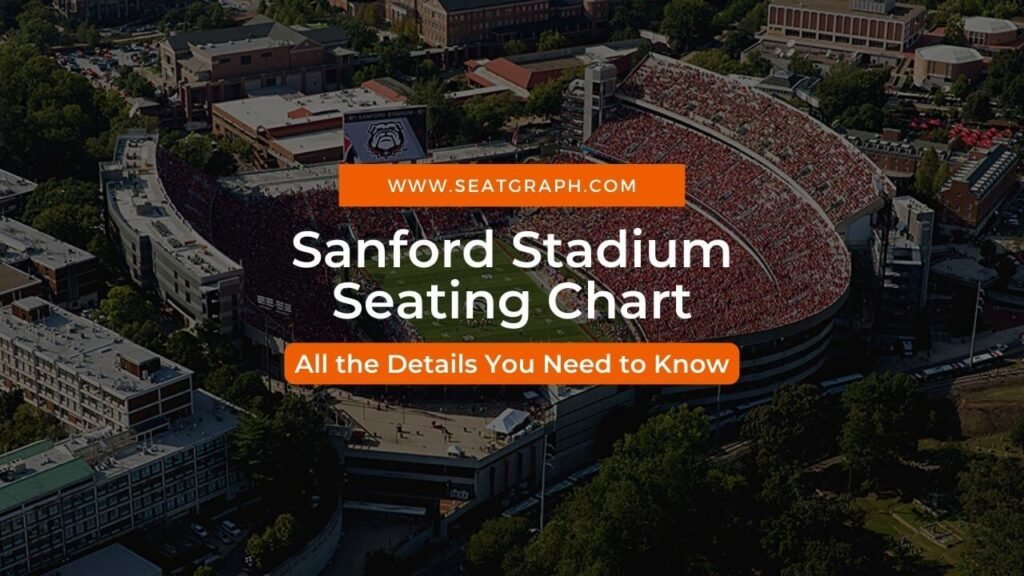What’s up football fans! Welcome back to the seatgraph.
Today we’re diving deep into one of the most ambitious stadium projects in English football right now – Leeds United’s Elland Road Stadium expansion plan.
We’re talking about a potential £200 million investment that could completely change the landscape of football in Yorkshire.

Elland Road: History & Current Need
Now, if you’ve been following Leeds United, you know this isn’t just any stadium – this is Elland Road, home to some of the most passionate fans in world football. But here’s the thing – while the atmosphere has always been electric, the infrastructure? Well, let’s just say it’s been showing its age.
Currently sitting at around 37,800 capacity, Elland Road has been crying out for modernization.
But what the 49ers Enterprises ownership group has planned? It’s absolutely mind-blowing. We’re talking about potentially expanding to 55,000 to 60,000 seats, which would make it one of the largest club stadiums in England.
So grab your tea, settle in, because we’re about to break down everything you need to know about this game-changing project.

The West Stand: Centerpiece Redevelopment
Let’s start with the centerpiece of this entire project – the West Stand. Now, this isn’t just a little touch-up job we’re talking about here. This is a complete demolition and rebuild of a stand that’s been standing since the 1970s.
The new West Stand is going to be absolutely massive. We’re talking about a complete reimagining of what this side of the ground can be. The current plans show a modern, multi-tiered structure that’s going to house thousands more fans while completely revolutionizing the matchday experience.
Capacity Transformation & League Standing
Here’s where it gets really exciting – this single stand redevelopment is the key to jumping from that current 37,800 capacity all the way up to potentially 60,000. That’s an increase of over 20,000 seats! To put that in perspective, that’s like adding an entire League One stadium’s worth of fans to every single match.
If they hit that 60,000 target, Elland Road would leap into the conversation with stadiums like Arsenal’s Emirates, Manchester City’s Etihad, and Tottenham’s new ground. We’re talking about transforming Leeds from having one of the smaller grounds in the top flight to having one of the biggest.
The Financial Game-Changer
Now let’s talk money, because this is where things get really interesting. The West Stand alone is projected to cost over £100 million. Just the West Stand! When you factor in all the associated works, infrastructure improvements, and potential future developments, we’re easily looking at £200 million or more.
This is where the 49ers Enterprises ownership comes into play. These aren’t small-time investors – we’re talking about the same group behind the San Francisco 49ers NFL team. They understand stadium economics, they understand the value of premium facilities, and most importantly, they’ve got the financial backing to make this happen.
FFP & Matchday Revenue Revolution
But here’s the real kicker – this isn’t just about having a bigger stadium. This is about Financial Fair Play. In today’s football landscape, matchday revenue is absolutely crucial for clubs to compete at the highest level. The more premium seats, hospitality boxes, and corporate facilities you have, the more revenue you can generate on every single matchday.
Look at clubs like Tottenham or Arsenal – their new stadiums aren’t just about capacity, they’re revenue-generating machines. Every corporate box, every premium seat, every hospitality package is money in the bank that helps them compete for the best players and stay within FFP regulations.
Hospitality: Elevating the Experience
Let’s dive deeper into the hospitality aspect, because this is where Leeds United is really looking to transform their business model. The current Elland Road, while atmospheric, is seriously lacking in premium offerings.
Right now, if you want a premium experience at Elland Road, your options are pretty limited. Compare that to what modern stadiums offer – private boxes, premium lounges, fine dining experiences, exclusive bars – it’s like comparing a corner shop to Harrods.
The new West Stand is going to completely flip this script. We’re talking about state-of-the-art hospitality suites, premium lounges with panoramic views, corporate boxes that rival anything in the Premier League, and dining experiences that’ll make you forget you’re at a football match.
The Revenue Potential
Here’s where the business case gets really compelling. A single corporate box can generate anywhere from £50,000 to £200,000+ per season, depending on the level of service and exclusivity. Multiply that by dozens of boxes, add in premium seating packages, hospitality lounges, and special event hosting capabilities, and you’re looking at tens of millions in additional annual revenue.
This isn’t just speculation – we’ve seen this playbook work elsewhere. When Tottenham moved to their new stadium, their matchday revenue jumped from around £30 million to over £80 million per year. That’s the kind of transformation Leeds United is aiming for.
Current Project Status & Planning
Now, let’s talk about where we actually stand with this project. The good news? Full planning permission was granted by Leeds City Council back in July 2023. That’s a massive hurdle cleared.
But here’s where things get a bit murky. As of mid-2025, there’s still no fixed construction start date. Now, don’t panic – this is actually pretty normal for projects of this scale. The detailed design work is ongoing, and there are countless technical, logistical, and financial elements that need to be perfectly aligned before you can break ground on a £200 million project.
Incremental Improvements & Phased Approach
What’s encouraging is that Leeds United hasn’t been sitting idle. In summer 2023, they installed a brand new hybrid pitch – the same technology used at Wembley and other top stadiums. They’ve also upgraded the South Stand media facilities, showing they’re committed to incremental improvements while planning the big transformation.
From what we understand, this is going to be a phased approach. You can’t just demolish an entire stand and disappear for two years – the club needs to maintain operations, continue hosting matches, and keep revenue flowing. This means careful planning around fixture lists, potential temporary capacity reductions, and maintaining the famous Elland Road atmosphere throughout construction.
Logistical Challenges
The logistical challenges are immense. We’re talking about a working stadium that hosts matches almost every other weekend, plus potential European competitions, cup games, and other events. Construction teams will need to work around this schedule while dealing with one of the most complex engineering projects in Yorkshire.
Future Vision: Beyond the West Stand
But wait, there’s more! The West Stand is just the beginning. The club has already flagged the East Stand for potential future development. Imagine if they eventually redevelop that side of the ground too – we could be looking at a truly massivestadium that rivals anything in English football.
If both the West and East stands get the full treatment, some estimates suggest Elland Road could potentially reach capacities of 65,000 or even 70,000. That would put it in the conversation with Old Trafford and potentially make it the largest club stadium in England outside of Manchester United.
Economic Impact on the Area
This isn’t just about Leeds United either. A project of this scale transforms the entire area around the stadium. We’re talking about increased foot traffic, new businesses, job creation, and making Elland Road a destination that goes beyond just matchdays.
Look at what happened around Tottenham’s new stadium – entire neighborhoods have been revitalized. Restaurants, bars, shops, hotels – it becomes an economic engine for the entire area.
Acknowledging the Challenges
Now, let’s be realistic about the challenges ahead. Projects of this scale are incredibly complex. We’re not just talking about building a new stand – we’re talking about completely reimagining the infrastructure around one of England’s most famous football grounds.
Weather, supply chain issues, regulatory approvals, utility relocations, traffic management – any one of these could impact timelines. Plus, Leeds United needs to balance the construction timeline with their football ambitions. If they’re pushing for promotion or competing in Europe, that affects when and how construction can proceed.
There’s also the financial timeline to consider. £200 million doesn’t just appear overnight, even for owners with deep pockets. The project funding needs to be structured carefully, especially with FFP considerations and the need to maintain competitive squad investment.
I know Leeds fans are eager to see spades in the ground, but patience is going to be key here. Getting this right is more important than getting it fast. The last thing anyone wants is to rush into construction and end up with cost overruns, delays, or worse – a substandard result.
Conclusion & Vision Recap
So there you have it – Leeds United’s incredible vision for transforming Elland Road into one of English football’s premier destinations. We’re talking about a project that could more than double matchday revenue, increase capacity by over 50%, and create one of the most impressive stadiums in world football.
Let’s recap those key numbers: potentially 60,000 capacity, over £100 million for the West Stand alone, £25 million in council backing, and a timeline that’s still being finalized but could see construction beginning in the next couple of years.
The 49ers Enterprises ownership group clearly has massive ambitions for this club, and this stadium project is the foundation for everything they want to achieve. If executed properly, this could be the catalyst that helps Leeds United compete with the biggest clubs in English football for generations to come.
Call to Action
What do you think about Leeds United’s Elland Road stadium expansion plans? Are you excited about the potential, or worried about the timeline and costs? Let me know in the comments below, smash that like button if you enjoyed this deep dive, and don’t forget to subscribe for more football stadium content like this.
Until next time, keep supporting your club, and I’ll see you in the next one!



